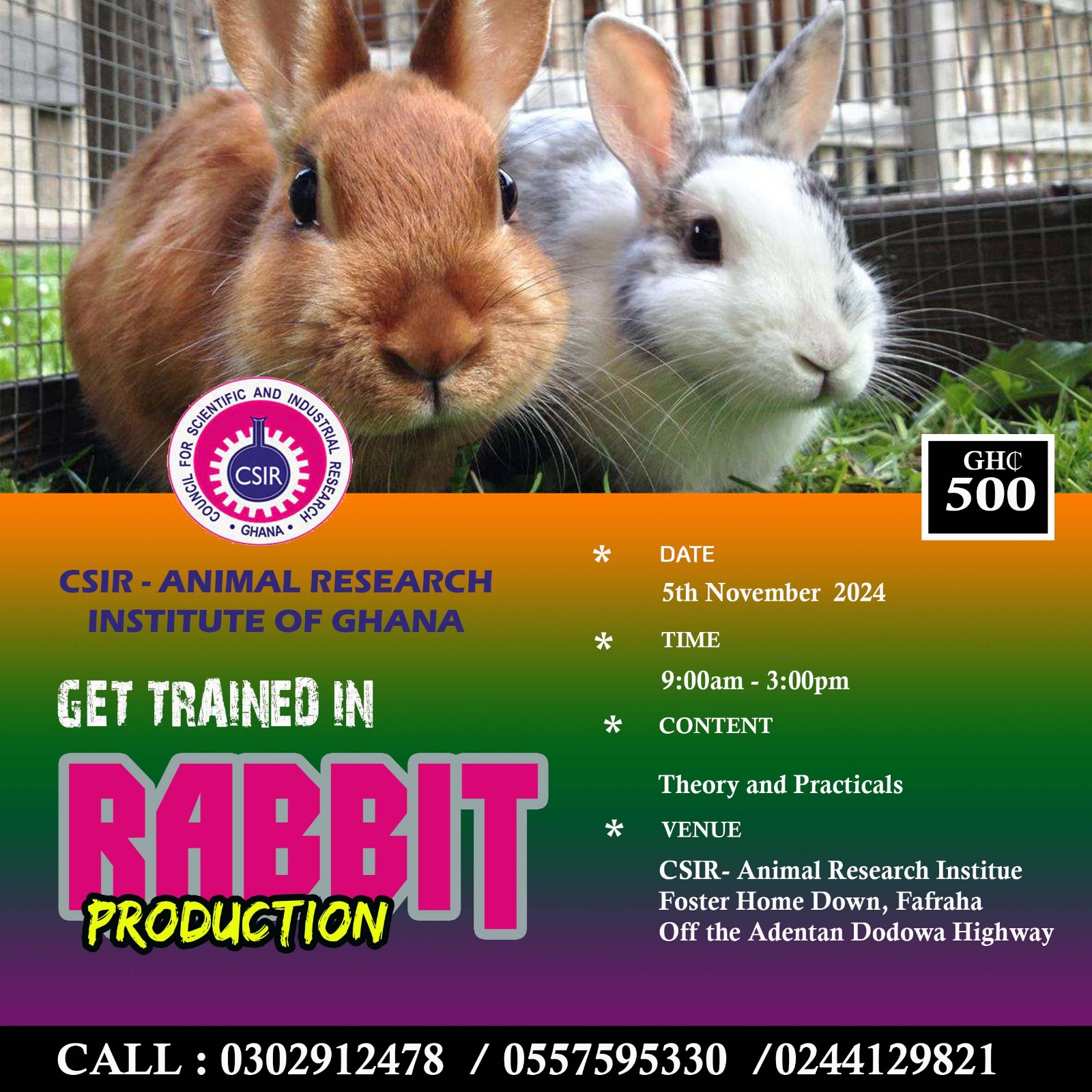Executive Summary
The research and development activities of CSIR-Animal Research Institute in the year 2023 were reported on the following thematic areas: Food security and poverty reduction (livestock and poultry): Biomedical and public health; and Science and people: technology for livelihood and wealth creation as well as value chain promotion. Under the food security and poverty reduction theme, preference studies were conducted to find out which plants rabbits would prefer most. Four plants were compared and it emerged that rabbits preferred Brassica oleracea leaves most. Another study experimented with adding ground corncobs at 10% to the diet of chickens and they realized that giving corncobs will reduce performance compared with the standard commercial diet, but if an enzyme or flaked oyster mushroom is added to the corncob diet, it will restore the performance of the birds as if they are consuming the standard commercial diet. This study clarifies how even corncobs can be utilized as chicken feed rather than allowing them to be a nuisance. Yet another study’s focus was to determine the essential amino acid as well as sulphur- containing amino acid contents in the leaves of four plants commonly fed to rabbits and the conclusion was that the contents of these essential amino acids and the sulphur-containing amino acids in the leaves of these plants were adequate to meet the nutritional requirements of rabbits. A study looked at the inclusion of different levels of bamboo meal leaf in the diet of growing rabbits and the investigators realized that a 15% or even a 20% inclusion level reduced the production cost via reducing feed cost while maintaining the final products of the rabbit comparable to a standard diet. Three Brachiaria (B. brizantha, B. ruzziziensis and Brachiaria species cv. mulato II) species were assessed in terms of quality and quantity for livestock feed. Soil and biomass samples were taken for laboratory analysis to assist in evaluating them and for the interpretation of the results. For use as pig feed, some scientists investigated the treatment of chopped plantain and banana stems with brown sugar, fermenting the product for one week and adding a beneficial microbe. This replaced 50% of maize in a pig diet, and the performance of pigs on this new diet was comparable to those on a standard diet...
The biomedical and public health research collection covers a broad spectrum, spanning agriculture, public health, environmental science, and animal studies with a predominant emphasis on the One Health approach. A clinical trial was conducted to explore the efficacy of ethnoveterinary preparations, specifically Bombax costatum and Evolvulus alsinoides decoction, as a treatment for Newcastle disease in chickens. The results demonstrated a significant reduction in mortality rates and increased hatching rates in the treatment group, suggesting the potential of these plant-based solutions in poultry disease control. In addressing the emergence of antimicrobial resistance (AMR), studies were undertaken across diverse sources, including food animals, water, and the environment. One study focused on the prevalence and AMR of E. coli causing avian colibacillosis (AvL), revealing high resistance to commonly used antimicrobials and emphasizing the urgency for informed veterinary practices. Another investigation into the presence and AMR patterns of Enterococcus spp. in healthy pigs highlighted the need for antimicrobial stewardship. A study on AMR Salmonella spp. in beef at slaughterhouses underscored the importance of sanitation measures and routine monitoring to mitigate transmission to humans. Additionally, examining the impact of increased influent wastewater volume on E. coli removal and AMR profiles in a sewage treatment plant, a study revealed efficient E. coli reduction but an increase in AMR patterns in effluent water, suggesting a potential environmental reservoir for AMR. Parasite infestation and its significance in zoonosis were explored in a study on the prevalence of Cryptosporidium spp. and other intestinal parasites in rabbits. The findings underscored the importance of further research to comprehend their spread and impact on public health. To enhance livestock management under global warming, an in-vitro study simulated thermal stress on Indian Gir cattle peripheral blood mononuclear cells (PBMC). The study demonstrated the utility of PBMCs as a cellular system to understand thermotolerance potential, offering insights for improved livestock management and performance. Another study investigated the impact of representative fatty acids on adipogenesis in 3T3-L1 cell culture. The outcomes revealed that eicosapentaenoic acid during the differentiation stage reduced intracellular triacylglycerol accumulation, offering valuable insights for potential obesity interventions.
In response to the increasing prevalence of malaria and acute dengue virus coinfection in Africa, a systematic review estimated the coinfection’s prevalence among acute undifferentiated febrile diseases. The findings emphasized healthcare workers to consider both diseases in the differential diagnosis of febrile illnesses in the region. On the aspect of technology for livelihood and wealth creation, a study was conducted to profile the clients of the livestock training in order to more appropriately tailor training needs to their education and income level. Hatchery experts tested different combinations of storage time and temperature regimes to determine the appropriate storage conditions for chicken eggs. Other teams working on poultry made recommendations on poultry manure management to reduce their environmental impact and make its use more climate friendly. An ongoing experiment tested the effect of different combinations of growth media and soil on germination and growth of cashew nut seedlings. Researchers evaluated the nutrient intake and growth performance of sheep under different management systems in northern Ghana and concluded that there is better nutrient availability in the more intensive systems compared to the more extensive ones, which reflected in better growth performance of sheep under the more intensive systems. In another study, 10 accessions of tropical forage seeds from two main tropical forages thus Brachiaria and Panicum species were evaluated to determine their agronomic performance for integration into the mixed farming system as a sustainable intensification pathway to increase smallholder farmers productivity and resiliency. The results showed that the forage varieties exhibited good potential with high possibilities of fitting well when integrated intothe mixed farming system. In 2023, a total of 20 refereed journal publications were recorded. For the financial year, the total operating income was GH₵ 19,568,403.36 and the total expenditure was GH₵ 19,424,100.29 leaving a surplus of GH₵ 144,330.07.
read full report here



